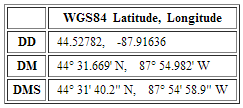
Sometimes folks incorporate geographic coordinates into a work product without fully understanding the mathematical and historical underpinnings of GC systems. The result can be coordinate pairs that define locations incompletely and/or ambiguously. The usual result of messing up the syntax is minor embarrassment, but sometimes the consequences are more serious. Official records of important land features or events can wind up incorrect or incomplete.
Coordinate System Name & Datum
A large number of earth models (datums) and corresponding geographic coordinate systems are currently in use. If the datum/coordinate system associated with a particular coordinate pair is not explicitly named, the spatial reference will be a guess and guessing wrong can result in significant positional error. The coordinate pairs in the above table are referenced to the World Geodetic System of 1984 as indicated by the “WGS 84″ in the table header.
Units
DD Notation – correctly written DD coordinate pair consists of numeric characters only. Including the ° symbol, or the word “degrees” or “decimal-degrees” in the written pair adds no useful information and renders the string less comprehensible to a computer. The table above includes an example of units used with DD coordinates.
DM and DMS Notations – correct interpretation of DM and DMS coordinate pairs requires that the degree symbol (°), the minute symbol (‘) and second symbol (“) be present. The table above includes examples of units used with DM and DMS coordinates.
Hemisphere Indicators
DD Notation – A correctly written DD coordinate pair consists of numeric characters only. Positive numbers (no leading sign) are used to indicate northern hemisphere latitudes and eastern hemisphere longitudes. Negative numbers (leading minus sign) are used to indicate southern hemisphere latitudes and western hemisphere longitudes. The table above includes an example of hemisphere indicators for DD notation
DM and DMS Notations – DM and DMS coordinates must include a letter “N” to indicate northern hemisphere latitudes, “S” to indicate southern hemisphere latitudes, “E” to indicate eastern hemisphere longitudes or “W” to indicate western hemisphere longitudes. The table above includes examples of hemisphere indicators for DM and DMS notation.
Pair Order
After many hours of research, we’ve come up with the answer to the question “Which number comes first in a GCS coordinate pair, the latitude or the longitude?” Here it is:“When writing a GCS coordinate pair, the technician must put the latitude first unless he/she prefers to put the longitude first”
So how does that settle the question? By confirming the technician’s responsibility to write GCS coordinates in a way that the reader can easily determine which number is which. In the table above, the header indicates that the first number in the pair is the latitude. An algebraic expression is another way to convey pair order; e.g. “WGS 84 latitude/longitude = 44.52782 / -87.91636”
Even though there is no hard and fast rule for pair order, I think it’s a good idea to be consistent in one’s own original work. I’ve decided to go with latitude first.

Comments are closed.